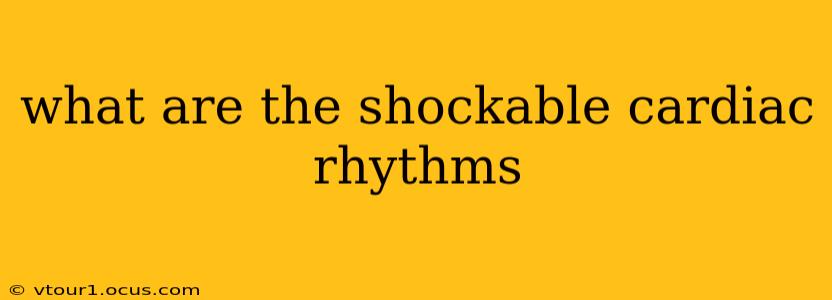What Are the Shockable Cardiac Rhythms?
Understanding shockable cardiac rhythms is crucial for anyone involved in emergency medical care. Defibrillation, the process of delivering a high-energy electric shock to the heart, is a life-saving intervention, but it's only effective for specific, life-threatening arrhythmias. Improper use can be dangerous, so accurate rhythm identification is paramount. This article will explain what makes a rhythm "shockable" and detail the two primary shockable rhythms.
What Makes a Cardiac Rhythm "Shockable"?
A cardiac rhythm is considered "shockable" if it represents a disorganized electrical activity in the heart that prevents effective blood pumping. Essentially, the heart is quivering (fibrillating) instead of beating in a coordinated way. This leads to a lack of cardiac output, causing circulatory collapse and potentially death. Defibrillation aims to reset the heart's electrical activity, allowing it to resume a normal rhythm.
Not all irregular heartbeats are shockable. Some slow or fast rhythms might be treated with medication or pacing, but not defibrillation. The key is identifying rhythms that are causing inadequate blood flow and are amenable to being "shocked" back to a normal rhythm.
What Are the Two Main Shockable Rhythms?
The two primary shockable rhythms are:
1. Ventricular Fibrillation (VF): This is a chaotic, disorganized quivering of the ventricles (the heart's lower chambers). VF is characterized by the absence of discernible waveforms on an electrocardiogram (ECG). The heart is essentially not pumping blood at all. VF is a life-threatening emergency requiring immediate defibrillation.
2. Pulseless Ventricular Tachycardia (pVT): In this rhythm, the ventricles beat rapidly and irregularly, but the heart is not effectively pumping blood because the rhythm is so fast and disorganized. The term "pulseless" is crucial here; if a pulse is present, the rhythm is not considered pulseless ventricular tachycardia. While the electrical activity is organized to a degree compared to VF, the rapid rate prevents adequate filling and ejection of blood. pVT requires immediate defibrillation as well.
Are There Other Potentially Shockable Rhythms?
While VF and pVT are the primary shockable rhythms, there are some situations where other rhythms might be considered for defibrillation, depending on the clinical context and the presence or absence of a pulse. This decision is always made by trained medical professionals considering the patient's overall condition. The judgment to defibrillate is based on the absence of a pulse and the assessment of the situation, not solely on the rhythm itself.
What Happens During Defibrillation?
Defibrillation involves delivering a high-energy electrical shock to the chest. This shock depolarizes the heart muscle, momentarily stopping all electrical activity, allowing the heart's natural pacemaker to potentially resume a normal rhythm. The process requires specialized equipment and training.
What If Someone Is Not Responding to Defibrillation?
If defibrillation is unsuccessful in restoring a normal rhythm, cardiopulmonary resuscitation (CPR) will continue alongside advanced life support measures.
How Can I Learn More About Cardiac Rhythms?
Comprehensive training in advanced cardiovascular life support (ACLS) is necessary to accurately interpret ECGs and manage these critical situations. Such training provides the knowledge and skills to identify and treat shockable and non-shockable rhythms effectively. This information is for educational purposes only and should not be considered a substitute for professional medical training.
This article provides a general overview; accurate diagnosis and treatment of cardiac arrhythmias require professional medical expertise. Always seek immediate medical attention if you suspect a cardiac emergency.
